This crusty olive bread is perfect for serving at your next dinner party, or alongside a cheese and charcuterie board. It’s sure to impress your guests, and they won’t have any idea how easy it actually is! There’s no kneading or complicated shaping involved, and the vast majority of time is hands-off. This loaf is soft inside with a crispy chewy crust, and includes garlic, oregano, and plenty of salty olives.
One reader, Shannon, commented: “Another phenomenal recipe. Had this last night with the Baked Chicken Meatballs—was so delicious. So much flavor and with minimal effort, especially for a bread. Did a mix of kalamata and green olives. Wonderful. ★★★★★“
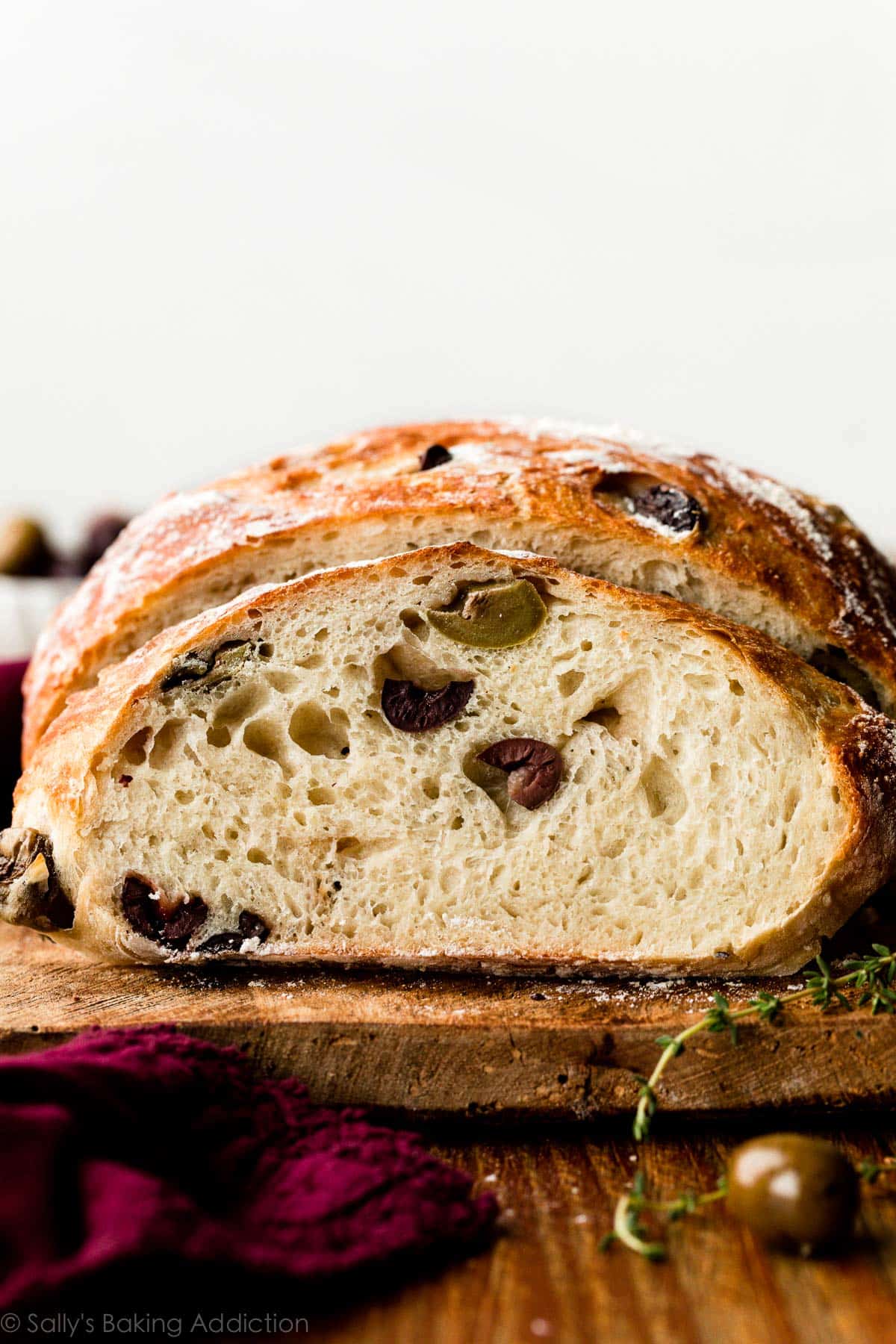
Another homemade yeast bread to love!
Don’t let your eyes fool you… the dark speckles in today’s bread are not chocolate chips and raisins. They’re olives! This recipe is based off of my homemade artisan bread, a wonderfully easy and widely popular no-knead bread that’s fit for both beginners and experts. (Note that I bake this bread at a slightly lower oven temperature because the olives can burn.)
A Flavorful Bread Recipe for Beginners
Today’s olive bread basically makes itself, so if you’re nervous to try homemade bread, this recipe is a great introduction. Even though the recipe is easy, the bread does NOT skimp on flavor. It’s just a simple way of baking homemade bread inspired by the no-knead technique originating from bread expert Jim Lahey. Here’s why it’s so simple:
- Only 7 ingredients
- Absolutely no kneading (just like homemade English muffins!)
- Zero complicated shaping
- No mixer required
- 90% of the time is totally hands off
- Can bake in a dutch oven or on a baking sheet
Plus, you can make it in 4 hours or let the dough rest in the refrigerator for up to 3 days (great make-ahead recipe!). Once you realize how easy it is to prepare salty, herby, garlicky olive bread, you’ll find any excuse to bake it.
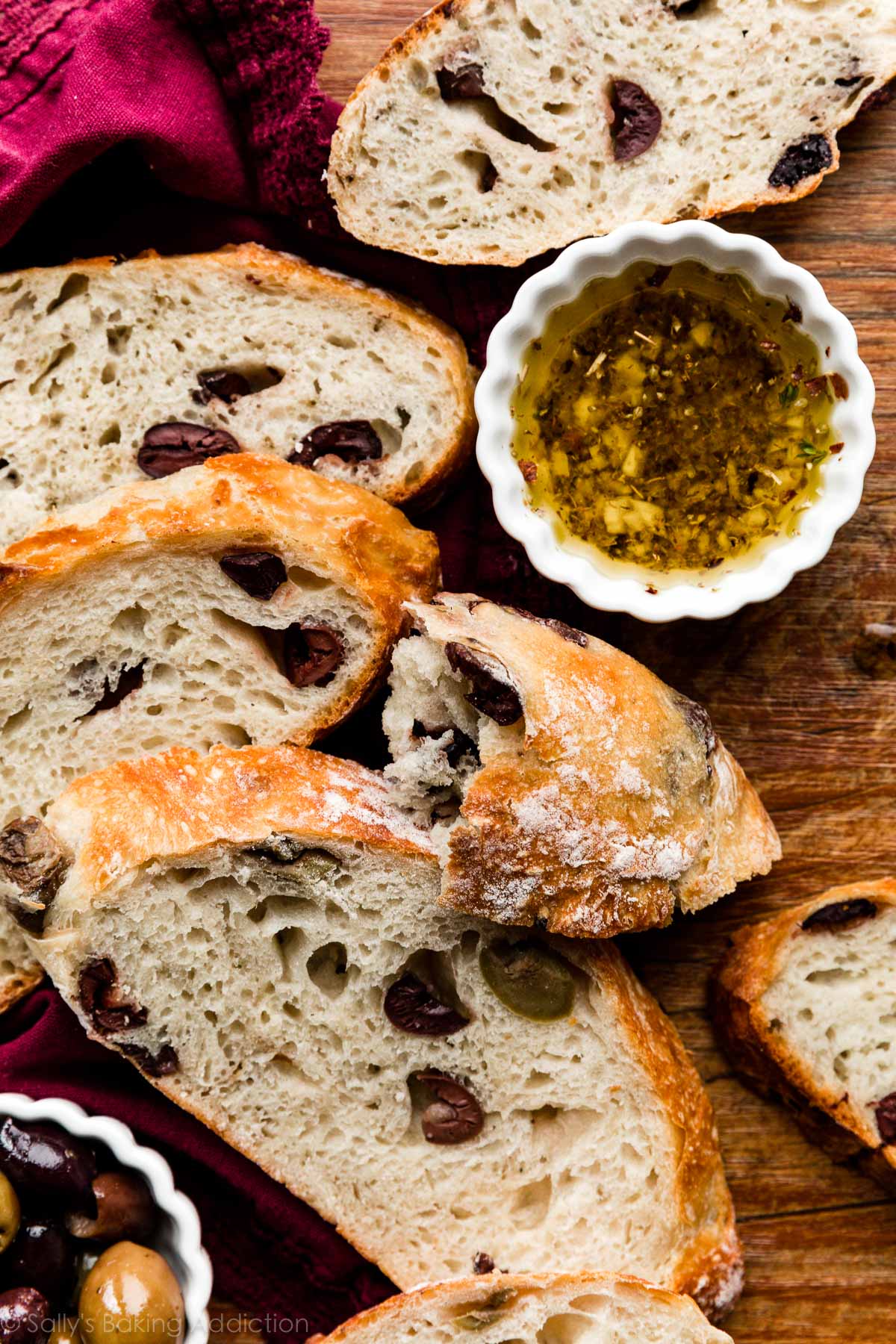
Key Ingredients You Need & Why
Today’s Mediterranean-inspired bread is an egg free baking recipe and dairy free recipe. Here are the ingredients you need:
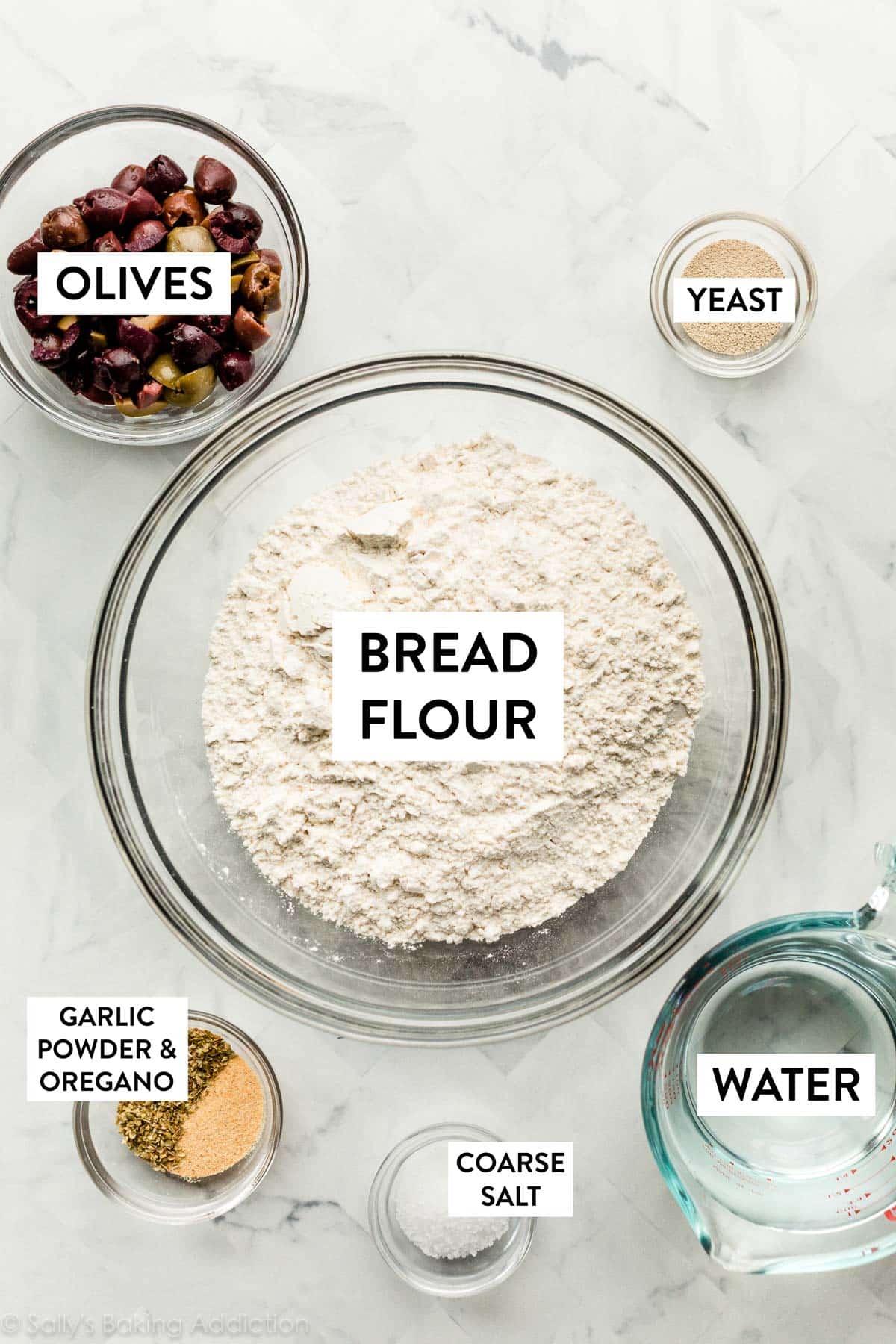
- Bread Flour: While you could use all-purpose flour in this recipe, I strongly recommend using bread flour. Bread flour produces a stronger, chewier bread and that makes a big difference in an artisan-style loaf like this olive bread or this homemade ciabatta bread.
- Instant Yeast: While you can use active dry yeast if that’s all you have, any quick-rise or instant yeast will produce flavorful results in less time. I use more yeast in this recipe compared to my cranberry nut no-knead bread and no-knead jalapeño cheddar bread. Why? Those doughs rest and rise at room temperature. However, for more flavor and just as much rise, I use more yeast and let this dough rest in the refrigerator. (Cool air slows the fermentation process and helps develop better flavor.)
- Salt: Just like with asiago-crusted skillet bread, I recommend using coarse salt because I find the bread’s flavor lacking with regular table salt.
- Garlic + Herbs: Dried oregano and garlic powder add flavor to the dough. You could also try some chopped fresh herbs or roasted garlic cloves, or simply leave them out. The recipe is pretty adaptable, just like the toppings for focaccia!
- Olives: See below for my recommendations.
- Water: I normally encourage you to use warm liquid with yeast, like we do in no knead seeded oat bread, because warm liquid helps the yeast work faster. However, use cool or room-temperature water here. Not freezing cold, not super warm… just cool to the touch. 70°F (21°C) is great, but the exact temperature doesn’t matter as long as it’s not warm. We use the same cool water method for no-knead honey oat bread.
- Optional Cornmeal: If you’re using a baking sheet, dust the pan with cornmeal for a pop of flavor and a little crunch. This is completely optional. If you have it, use it. If you don’t have it, dust the pan with flour.
Best Olives to Use
Kalamata olives are excellent in this bread, but you can use a medley of olives. I’ve made it both ways. Whatever you use, give the olives a rough chop.
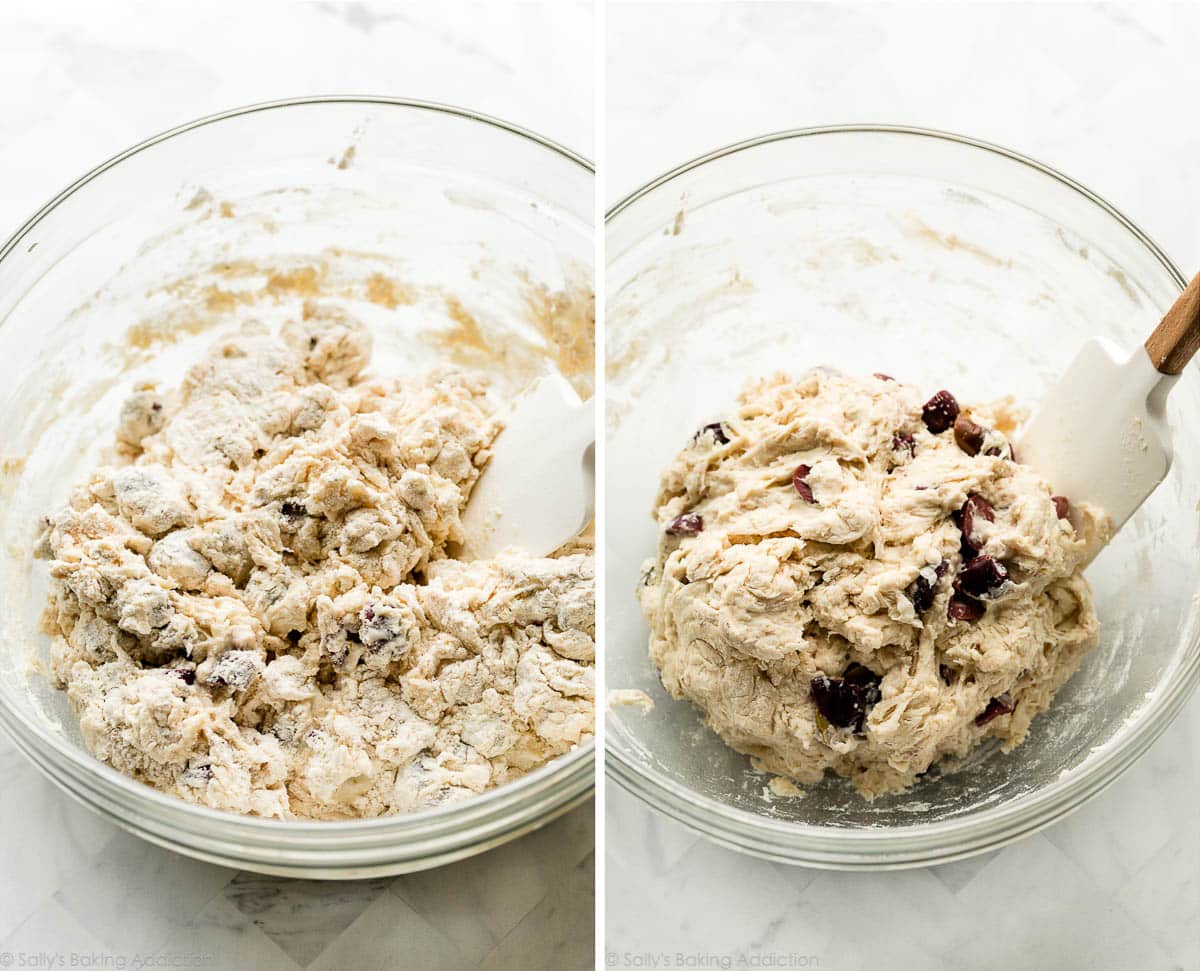
Let Me Show You How to Make This Olive Bread
Mix the dry ingredients together and then mix in the chopped olives and water. At first the dough will seem very dry and shaggy and you’ll question if it will even come together. (See above!) Use a spatula at first and then switch to your hands to ensure all of the flour is moistened. The dough is a little sticky after it’s thoroughly mixed.
Let it rise. Cover the dough and let it rise at room temperature for about 2–3 hours.

You can immediately continue with step 4 below (gently shaping before baking) or refrigerate the dough for up to 3 days. For best flavor, I strongly recommend refrigerating the risen dough even if it’s just for a couple hours.
After the dough rises and rests in the refrigerator, use generously floured hands to shape the dough into a round boule or ball-like shape:
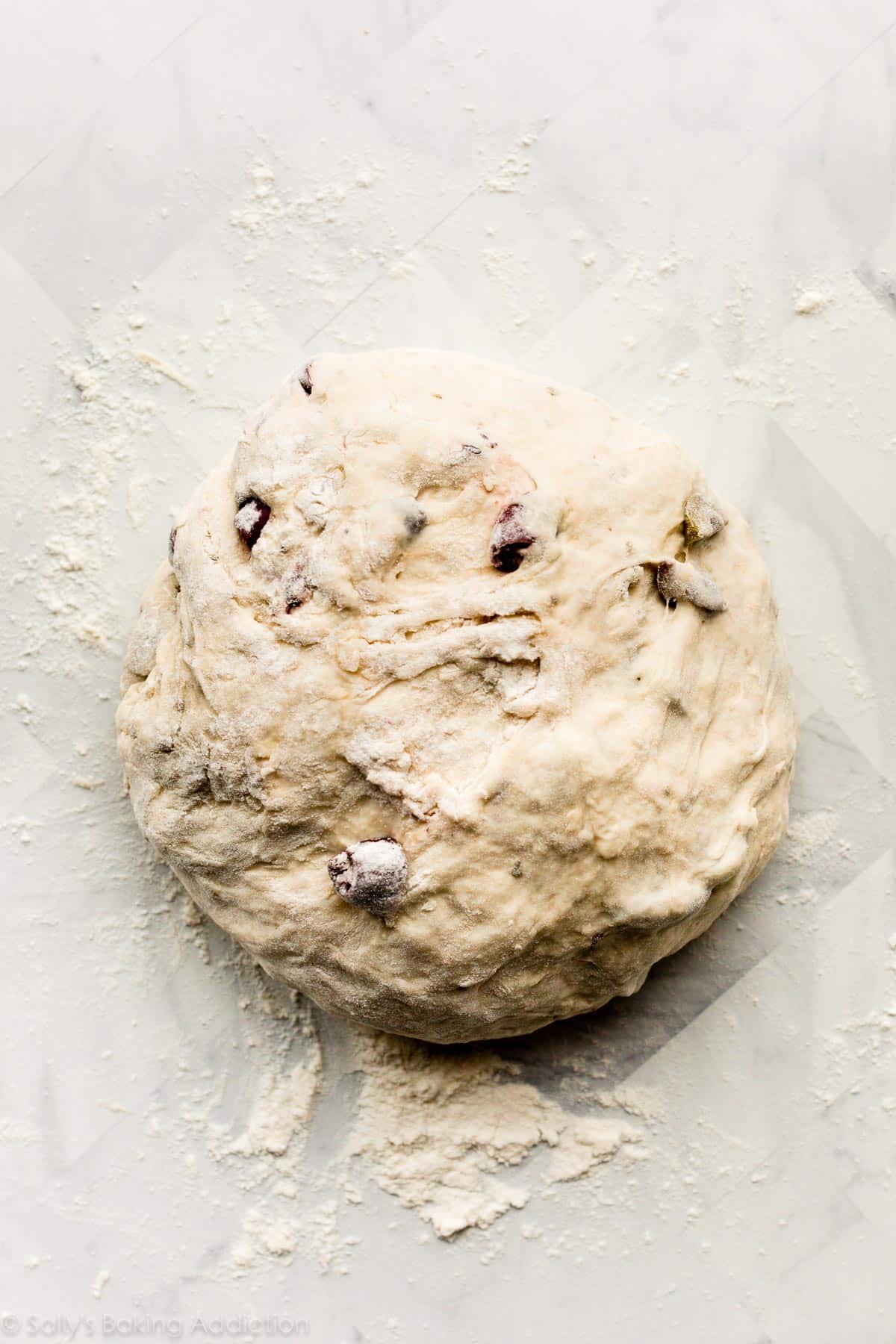
Now it’s time to choose between a dutch oven or baking sheet. This bread isn’t picky!
Use a Baking Sheet or Dutch Oven
You can use either. Baking the olive bread in a covered dutch oven traps steam inside the pot, creating that perfect crust. If you plan to bake a lot of bread in the future, you won’t regret picking up a dutch oven. If you don’t have a dutch oven, a nonstick large baking sheet is best. Let me explain both ways:
- Baking Sheet: Lightly dust it with flour and/or cornmeal. Place the dough on top, cover it, and let it rest as the oven preheats. You will find these detailed instructions in the recipe below, along with my crispy crust optional trick in step 7!
- Dutch Oven: Place the empty dutch oven with lid in the oven as it preheats. Place the dough on high heat resistant parchment paper (I use this parchment paper) and then fit inside a bowl. Cover and let the dough rest as the oven preheats, then place it (with the parchment) in the hot dutch oven before baking. You will find these detailed instructions in the recipe Note below.
Whichever you use, don’t forget to score the dough with a bread lame or sharp knife. Scoring allows the wet, airy dough to “breathe” as it rises and bakes.
Dutch oven method:
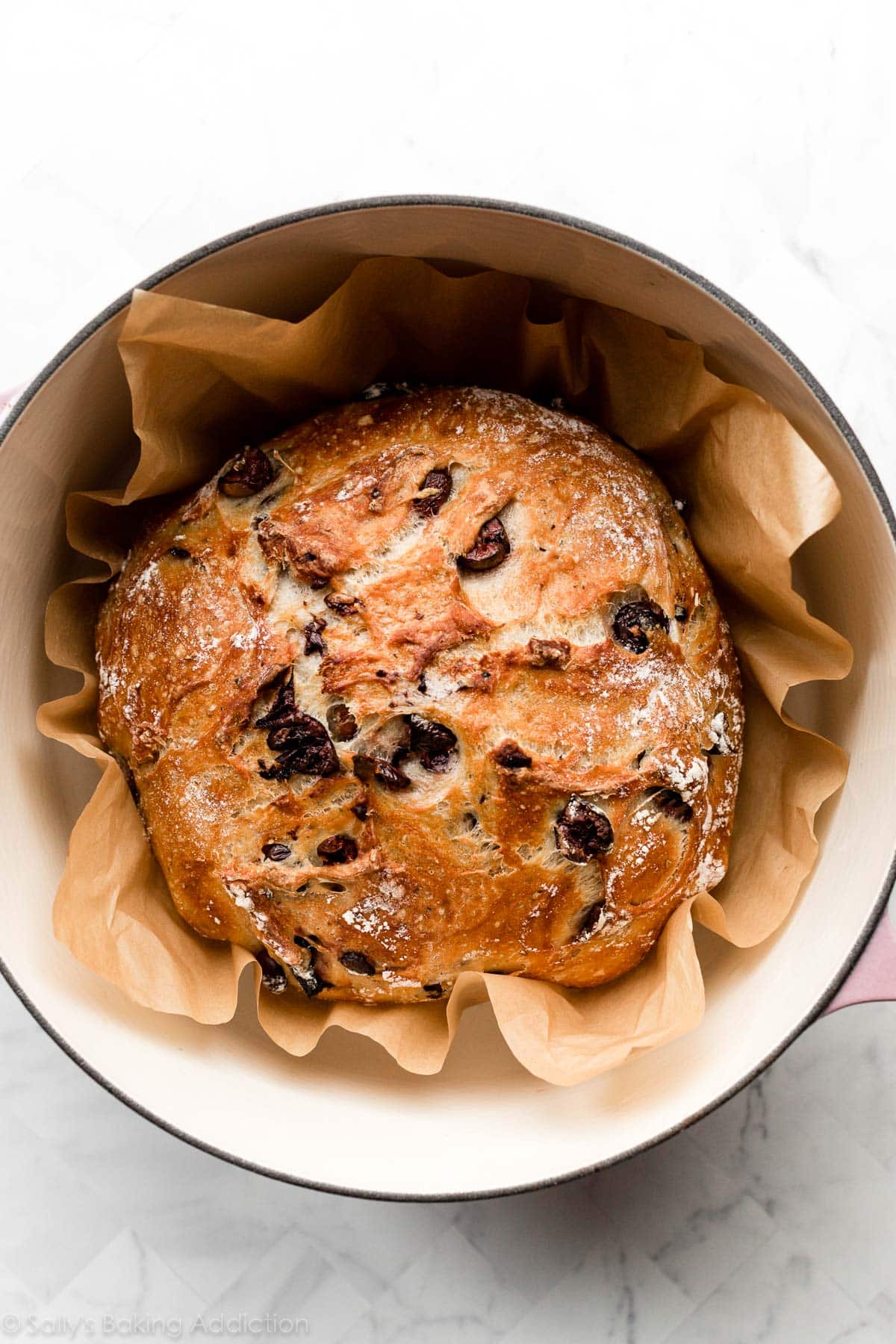
Baking sheet method:
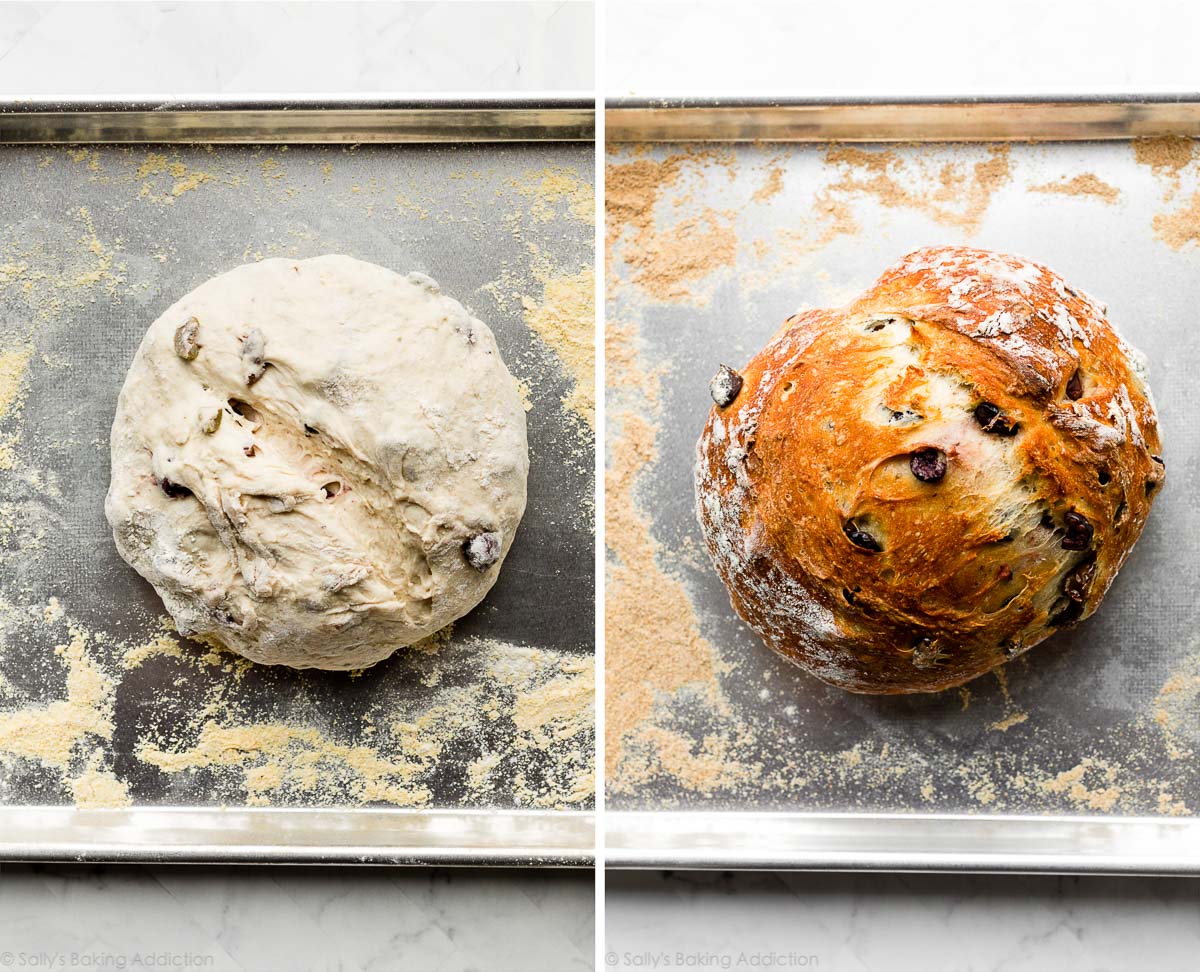

The bread is unbelievable when it’s fresh from the oven—warm, crispy, crusty, and soft inside!
What Can I Serve With This Olive Bread?
Honestly, it’s fantastic plain. But I usually mix together a super easy + flavorful dipping oil: 3 Tablespoons (45ml) extra virgin olive oil and 2 minced cloves of garlic plus a sprinkle each of red pepper flakes, fresh or dried thyme, dried oregano, salt, and pepper. The bread would also be delicious paired with homemade pesto.
Serve your olive bread alongside a charcuterie or cheese platter, or with any Mediterranean-style fare. I love it with a big Greek salad and have even served it with minestrone soup, pesto shrimp, chicken meatballs, and lemon thyme chicken. (The chicken dish has so much sauce for soaking! Lemon thyme chicken is another excellent option.)
Print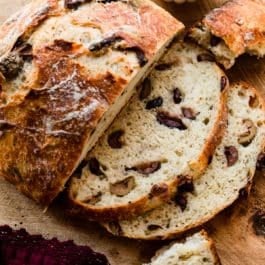
Easy No-Knead Olive Bread
- Prep Time: 4 hours
- Cook Time: 35 minutes
- Total Time: 4 hours, 35 minutes
- Yield: 1 loaf; 10-12 servings
- Category: Bread
- Method: Baking
- Cuisine: American
Description
Follow this recipe and enjoy homemade olive bread that’s altogether crisp, soft, garlicky, herby, and salty. Review Notes before beginning. If you’re new to working with yeast, reference my Baking with Yeast Guide for answers to common yeast FAQs.
Ingredients
- 3 and 1/4 cups (about 430g) bread flour (spooned & leveled), plus more as needed for shaping and pan
- 2 teaspoons instant or active dry yeast
- 2 teaspoons coarse salt (see note)
- 2 teaspoons dried oregano
- 1 and 1/2 teaspoons garlic powder
- 1 heaping cup (about 135g) roughly chopped olives
- 1 and 1/2 cups (360ml) water, close to room temperature at about 70°F (21°C)
- optional: cornmeal for dusting pan
Instructions
- In a large un-greased mixing bowl, whisk the flour, yeast, salt, oregano, and garlic powder together. Using a silicone spatula or wooden spoon, mix in the olives. Pour in the water and gently mix together. The dough will seem dry and shaggy, but keep working it until all the flour is moistened. If needed, use your hands to work the dough ingredients together. The dough will be sticky. Shape into a ball in the bowl as best you can. (Tip: Stir dough by hand. Dough is too sticky for a mixer.)
- Keeping the dough in the bowl, cover the dough tightly with plastic wrap or aluminum foil and set on the counter at room temperature (honestly any normal room temperature is fine). Allow to rise for 2-3 hours. The dough will just about double in size, stick to the sides of the bowl, and have a lot of air bubbles.
- You can continue with step 4 immediately, but for absolute best flavor and texture, I strongly recommend letting this risen dough rest in the refrigerator for at least 12 hours and up to 3 days. (Even just a couple hours is good!) Place covered dough in the refrigerator for up to 3 days. The dough will puff up during this time, but may begin to deflate after 2 days. That’s normal and nothing to worry about.
- Lightly dust a large nonstick baking sheet (with or without rims and make sure it’s nonstick) with flour and/or cornmeal. Turn the dough out onto a floured work surface. Using generously floured hands, shape into a ball as best you can. Dough is very sticky. Transfer to prepared baking sheet. Loosely cover and allow dough to rest for 45 minutes. You will bake the dough on this prepared baking sheet. See recipe note if you want to use a pizza stone or dutch oven.
- During this 45 minutes, preheat the oven to 425°F (218°C).
- When ready to bake, using a very sharp knife or bread lame (some even use kitchen shears), score the dough with a slash or an X, about 1/2 inch deep. (“Score” = shallow cut.) If the shaped loaf flattened out during the 45 minutes, use floured hands to reshape into a ball.
- Optional for a slightly crispier crust: After the oven is preheated and bread is scored, place a shallow metal or cast iron baking pan or skillet (I usually use a metal 9×13-inch baking pan) on the bottom oven rack. Carefully and quickly pour 3-4 cups of boiling water into it. Place the scored dough/baking pan on a higher rack and quickly shut the oven, trapping the steam inside. The steam helps create a crispier crust.
- Place the shaped and scored dough (on the flour/cornmeal dusted pan) in the preheated oven on the center rack. Bake for 35-40 minutes or until the crust is golden brown. How to test for doneness—give the warm loaf a light tap. If it sounds hollow, it’s done. For a more accurate test, the bread is done when an instant-read thermometer reads the center of the loaf as 195°F (90°C).
- Remove the bread from the oven and allow to cool for at least 10-20 minutes before slicing and serving. Store leftovers loosely covered at room temperature for up to 3 days or in the refrigerator for up to 10 days.
Notes
- Make Ahead & Freezing Instructions: The dough can sit in the refrigerator for up to 3 days, so this is a wonderful recipe to begin ahead of time. You can also bake the bread, allow it to cool, and freeze for up to 3 months. Thaw in the refrigerator and allow to come to room temperature before serving. You can also freeze the dough. Complete the recipe through step 3. Wrap in plastic wrap and place in a freezer-friendly container. Freeze up to 3 months. To bake, allow dough to thaw overnight in the refrigerator, or for 2–3 hours at room temperature. Continue with step 4 and the rest of the recipe instructions.
- Special Tools (affiliate links): Glass Mixing Bowls | Wooden Spoon or Silicone Spatula | Baking Sheet or Dutch Oven | 2-Cup Measuring Cup | Bread Lame | Instant-Read Thermometer | Coarse Sea Salt
- Flour: For absolute best flavor and chewy texture, I strongly recommend using bread flour. You can use a 1:1 substitution of all-purpose flour in a pinch with no other changes to the recipe. I recommend avoiding whole wheat flour in this dough, however if necessary, you can replace up to 1 cup (about 130g) of the bread flour with whole wheat flour.
- Yeast: You can use instant or active dry yeast, but I highly recommend an instant (aka “rapid rise” or “quick rise” yeast). The bread will rise faster. 2 teaspoons is a little less than 1 standard packet. If using active dry yeast, there are no changes needed to the recipe. The rise time in step 2 may take longer. Reference my Baking with Yeast Guide for answers to common yeast FAQs.
- Salt: Use a coarse salt, such as coarse sea salt, in this bread. I find the flavor slightly lacking when using regular table fine salt. If you only have fine salt, reduce to 1 and 1/2 teaspoons.
- Dried Oregano & Garlic Powder: Feel free to use 2-3 teaspoons chopped fresh oregano or substitute 2 teaspoons of another dried herb you love. Instead of garlic powder, you can use 2 teaspoons minced fresh garlic or roasted garlic.
- Using a Dutch Oven: The process is similar to Cranberry Nut No-Knead Bread. You need a 6 quart or higher dutch oven or any large oven-safe pot with a lid (lid is crucial—see cranberry nut no-knead bread for more information). Prepare dough recipe above through step 3. Turn the dough out onto a lightly floured work surface and, using lightly floured hands, shape into a ball as best you can. Doesn’t have to be perfect. Transfer dough to a large piece of parchment paper. (Large enough to fit inside your pot and one that is safe under such high heat. I use this parchment and it’s never been an issue.) Lift the parchment paper and dough up and place it all into a large mixing bowl. Using a very sharp knife or bread lame, gently score an X into the top. Cover dough lightly with plastic wrap and leave alone for 30 minutes. During this 30 minutes, preheat the oven to 425°F (218°C). Place your dutch oven (with the lid) inside for 30 minutes so that it’s extremely hot before the dough is placed inside. After 30 minutes, remove the dutch oven from the oven and carefully place the dough inside by lifting it up with the parchment paper and sticking it all—the parchment paper included—inside the pot. Cover with the lid. Bake for 30 minutes with the lid on. Carefully remove the lid and continue baking for 10 more minutes or until the bread is golden brown. You can test for doneness exactly how you would in step 8 above. Remove pot from the oven, carefully remove the bread from the pot, and allow to cool on a wire rack for 10-20 minutes before slicing/serving.
- Using a Pizza Stone: If you want to bake your bread on a pizza stone, place pizza stone in the preheating oven. Remove hot pizza stone, dust with cornmeal or a little flour, and then transfer shaped and scored dough to hot pizza stone and bake as directed.
- No Nonstick Pan?: If you don’t have a nonstick baking sheet, line it with parchment paper instead. Coat with a dusting of flour and/or cornmeal before placing the dough on top. Parchment paper can burn, so it’s best to check the box to see how much heat yours can tolerate. Lower your oven heat if necessary, and bake the bread for longer until it’s golden brown and sounds hollow when tapped.

















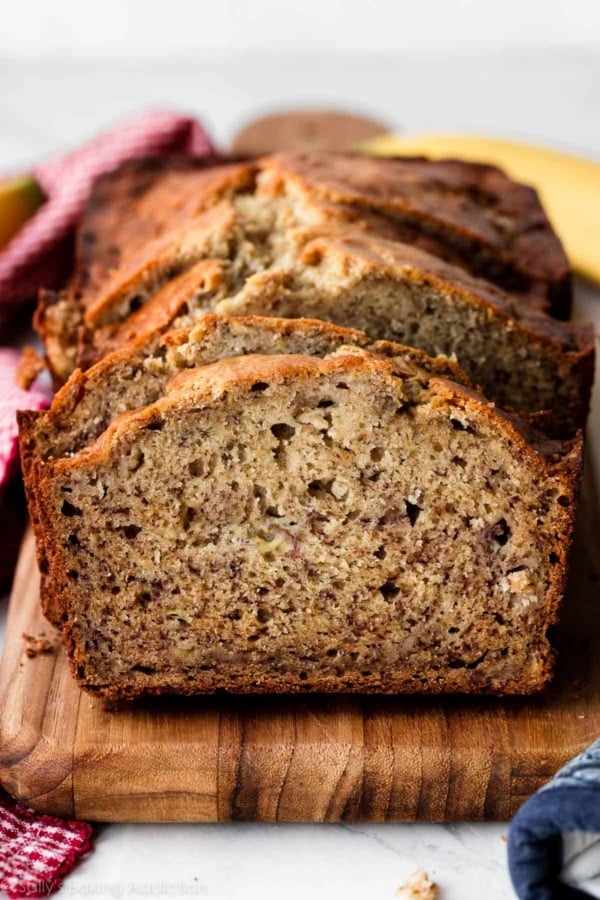

Reader Comments and Reviews
Thanks for such an amazing bread recipe, it is PERFECTION!!! I love it, my family and friends swoon over it, and I’ve shared the recipe over and over. I’m wondering, do you have a faux sourdough bread recipe, or how can I adapt this recipe to imitate sourdough? You must have that magic somewhere to share!!!
Hi Crystal! We don’t have a faux sourdough bread recipe and we don’t have any experience with sourdough. Sorry we can’t help more!
Delicious & so easy to make! I’m very new to baking yeasted breads. My goal for 2025 is to get over my fear of yeast! I made this bread with a combo of kalamata & castelvetrano olives – very tasty! Sally, I’ve leaned so much from you. Thanks for the wonderful instructions and resource info for a beginner!
Made it and it is great. Nice thin crust and soft inside love it.
I have the dough chilling overnight in my back fridge. I plan on baking tomorrow afternoon (will b 24 fridge time). Im a bit concerned on peoples comments about it being salty. Nothing i can do about it now. I plant on baking it in my bread cloche – i think thats whats its called. A big high domed bread baker instead of a dutch oven. Wish me luck
Best of luck, Maria! Let us know how it goes 🙂
Seems to be a difference in the size of Dutch ovens people use, anywhere from 3qt all the way up to a 7qt which I don’t understand. And does it need to be a Lodge brand?
Hi Cindy, different volume Dutch ovens will work better for different recipes. For a large boule loaf of bread, we recommend a 6-qt or larger Dutch oven. It can be any brand.
I saw the notes re using all purpose flour. How would it turn out if I used all purpose flour? Is the texture still lovely?
Hi Karen, the bread won’t be quite as chewy when using all-purpose flour.
P.s. If you are using metric measurements, check the equivalency charts. I found using the posted US measurements and doing the conversions myself (different than posted), my end product was 90% better.
This is a good “same day” bread recipe. Yeah, I know, it is better if you leave it in the fridge overnight/several days – but when you wake up and want bread TODAY, this fits the bill nicely. I used a combo of kalamata and castelvetrano olives and added a handful of freshly-grated pecorino-romano cheese (I don’t know exactly how much – I had a small block left in the cheese drawer and used it all up) – otherwise, I followed the recipe as written. Easy-to-make, delicious to eat. Thanks, Sally.
Thank you so much for this recipe. I couldn’t wait to make it and after following instructions I decided to bake it after the 3 hours using my pizza stone. It tastes awesome! and a perfect complement to my meatballs/spaghetti dinner. Thanks again!!
This is definitely a make again! Easy and super delicious.
Also, just a general expression of appreciation to Sally. I’ve made quite a few recipes from this site over the past few years. There’s never been a bad product. This is my first stop for recipes.
Thank you so much for making and trusting our recipes, Heather!
Sally I’ve been baking your no kneed breads to rave reviews from family and friends. Recently I tried baking them while in the desert (Palm Springs) and both times the dough didn’t look right and they were dry and didn’t rise. Same yeast, weighed my flour, etc… could it be the dryness and might I need to add more water?
Hi Kathleen, the temperature and/or humidity can definitely affect bakes like this. We’d start by trying just a bit more water—it may take some trial and error. Let us know what you try!
These recipes are fantastic! I’ve made it several times now and every time they taste great. The one difficulty I have is that the dough is so moist and sticky that I can’t seem to shape it properly so it always comes out a bit wonky looking. Would you recommend adding more flour to stiffen the dough a bit so I can shape it into a ball? Thanks
Hi Daniel! It should be a sticky dough. Make sure to generously flour your hands when working with the dough to prevent it from sticking too much.
My husband and I have always loved olive bread and are delighted that we can now make it at home! Thank you! … One point of slight friction though. My husband insists on refrigerating the bread after it cools and we slice (since olives are refrigerated after opening). I would much rather keep it at room temp for a few days. How do you normally store this bread? Thank you!
Hi Sue! Store leftovers loosely covered at room temperature for up to 3 days or in the refrigerator for up to 10 days. We usually store it at room temperature, since it’s usually gone in just a couple days!
Easy and delicious! I weigh my flour fwiw. Crusty outside, soft inside. It is a bit saltier than other breads I have made, but olives are briny. I also used a thermometer as suggested and I baked an additional 5 minutes based on that. I will bake again! Thanks for the recipe!
I’ve made this bread so many times now, both for us and for others. I wanted to make smaller loaves for Christmas gifts so I split one batch in 3 loaves and baked them for 30 min (my regular size loaf would always take a little over 40 min).
Great recipe! I did add extra olives to my recipe, the bread came out slightly moist and a little gummy. Should I up the temperature when baking? I used a Dutch oven and put a few ice cubes in it too.How do I get a more open crumb and oven spring?
Hi Kat, this bread will be somewhat moist, especially with the olives adding moisture. The middle part will be soft, but if it seems too moist/doughy then it’s possible it needs a few minutes longer in the oven. If your olives seem especially wet, you give lightly blot them with a paper towel before adding to your dough next time. Glad to hear you enjoy this bread!
I’ve never made bread before besides the bread oven and these kind of loaves are my favorite, crusty on the outside soft on the inside. I’m not a big fan of olives though, can I add roasted garlic instead?
Hi Audrey! Yes, absolutely. You can use any add-ins you would like here. Or you could start with our similar homemade artisan bread recipe.
The bread tastes great! I am still cooking it like double time from what is above. I’m using a cookie sheet and have the oven at 425. It’s crusty on the outside and wet in the middle.
Love your recipes! I’ve made the No Knead Cranberry Nut bread several times and it’s delicious. I’ve also made this recipe and enjoyed it too. Could this recipe be adapted to include both Kalamata olives and artichoke hearts? If so, what recommendations would you make the bread with these ingredients?
Hi Jan, Kalamata olives are excellent in this bread. We haven’t tried adding artichoke hearts, but you certainly could give it a try!
FYI
I made this recipe using both the chopped Kalamata olives and chopped marinated Artichoke quarters and it turned out great! I made sure to drain the olives and artichokes well (and blot if needed) before chopping. I used approximately 3/4 cup (80 g) of chopped olives and 1 cup (85 g) of chopped artichokes. Also used 1 teaspoon of coarse salt instead of 2. Otherwise, followed the rest of the recipe and instructions for Dutch oven and so far so good.
Loved the olive bread recipe!
Sally, it’s me again. I’ve made several of these loaves now and they are a big hit. I did purchase what I call a “bowl bonnet” to cover for proofing. However, I also have been putting the bowl in the frige for the extended proofing as you recommend. Do I need to oil the top of the dough if I place it in the frige overnight with the cloth bowl bonnet on it? It was suggested to me but I wanted to hear it from you. OR should I just use the plastic wrap like I have been doing for overnight?
Hi Cathy! Is the bowl bonnet air tight? If it is not, we would use plastic wrap for an overnight rise.
No it isn’t…I’m glad I checked. I’ll use plastic for overnight rises. Thank you.
Just tried the recipe. The inside is a bit wet and it’s on the salty side, other than that, it’s good. If I were to make it again, I would probably use 1/2 the stated amount of salt or even less.
I found that I had to cook it much longer in the dutch oven. No knead breads are typically cooked at higher temps (i.e. 450). I’m curious why this temp is set at 425 F.
Hi Sousou, olives can quickly burn, so that is why the temperature is reduced here vs. our cranberry nut no-knead bread.
Hi! I love this recipe. I was wondering if I could dump the dough in a loaf pan or shape it into a rectangle.
Hi Jamie! There is a little too much dough for a standard size (9×5 inches) loaf pan, but you could try dividing the dough in half and using 2 loaf pans. The edges should still crisp up and the bake time may vary.
Quite good, with modifications. It was way, way too salty. I had to throw out the first loaf, and then try again with just 1/4 of the salt.